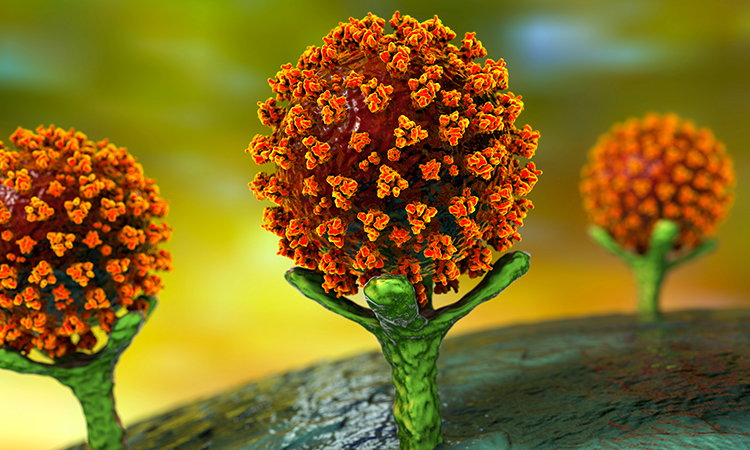COVID-19 drug targets and cell-based assays
Posted: 30 March 2021 | Alp Tegin Sahin (Kadir Has University), Sheraz Gul (Fraunhofer Institute) | No comments yet
The length of time between the administration of a COVID-19 vaccine and evidence of a robust immune response to Severe Acute Respiratory Syndrome coronavirus 2 (SARS-CoV-2) means that treatments are still required. In this article, Sheraz Gul and Alp Tegin Sahin explore the various therapeutic targets that have been identified to combat COVID-19 and the assays used to reveal the most promising drug candidates.


A truly remarkable achievement has been the rapid development of COVID-19 vaccines using novel technologies”
For those who contract the virus and require hospitalisation, the only small molecule drugs available for treatment are limited to remdesivir, dexamethasone and baricitinib, which have antiviral or anti-inflammatory properties.1 Currently, over 2,500 COVID-19 interventional clinical trials have been initiated, with around 600 of these in Phase III, according to ClinicalTrials.gov. Remdesivir was originally developed as early as 2009 to treat hepatitis C and was subsequently investigated for Ebola virus disease in 2016, before being studied as a post-infection treatment for COVID-19. It is noteworthy that the efficacy of the other drugs, namely dexamethasone and baricitinib, appear to be due to their ability to temper the “cytokine storm” which is observed in some individuals. Although inflammatory responses are normal during infection, if excessive, organs can consequently dysfunction. The cytokines of interest in COVID-19 that have been reported, leading to prolonged activation of signalling pathways, include MAPK, NfκB, JAK-STAT3, mTOR and JAK1/2. It is highly likely that most of the COVID-19 clinical trials will not yield safe and effective new drugs. Nevertheless, any further small molecule drugs that are approved would be expected to assist in future outbreaks of COVID-19 variants or related diseases.
COVID-19 drug targets
During 2021, it is expected that a number of COVID-19 small molecule clinical trials will be completed”
A truly remarkable achievement has been the rapid development of COVID-19 vaccines using novel technologies which enable expression of the SARS-CoV-2 Spike (S) protein, leading to an immune response. However, various efficacies have been reported and it is not possible to directly compare them, as efficacy is influenced by factors such as demographics, age and criteria for what constitutes as ‘severe’ and ‘moderate’ COVID-19 infection. There is emerging evidence that COVID-19 vaccines reduce infections and hospitalisations among older people almost six weeks after vaccination. This suggests the more rapidly acting small molecule drugs to treat COVID-19 and other related diseases will continue to be essential in the future. Examples of COVID-19 drug targets being explored for this purpose include viral and human proteins that are essential for viral function (see Table 1).
| COVID-19 viral targets | |
| COVID-19 structural proteins | COVID-19 non-structural proteins (nsps) |
| Envelope (E) protein | Main protease (3CLpro) |
| Membrane (M) protein | Papain-like protease (PLpro) |
| Nucleocapsid (N) protein | RNA-dependent RNA polymerase (RdRp) |
| Spike (S) glycoprotein | Endoribonuclease (nsp15) |
| Human targets | |
| Angiotensin I converting enzyme 2 (ACE2) | Adaptor-associated kinase 1 (AAK1) |
| Transmembrane serine protease 2 (TMPRSS2) | Cyclin G-associated kinase (GAK) |
| Furin | Phosphatidylinositol 3-phosphate 5-kinase (PIKfyve) |
| Cathepsin L | Two-pore channel (TPC2) |
Table 1: COVID-19 druggable viral and human proteins
A number of these COVID-19 drug targets have been investigated by researchers in cell‑based assay systems to discover small molecule modulators that can be used to treat the disease (Table 2).
| Target | Assay type | Reference compound | Drug discovery stage | Reference |
| RdRp | Cell-based | Remdesivir | Marketed | 2 |
| 3CLpro | Cell-based | Lopinavir | Marketed | 3 |
| PLpro | Cell-based | GRL0617 | Marketed | 3 |
| Endosomal acidification |
Cell-based | Chloroquine | Marketed | 4 |
| ACE2 | Cell-based | Telmisartan | Phase IV | 5 |
| TMPRSS2 | Cell-based | Camostat | Phase II | 6 |
| Cathepsin L | Cell-based | SID26681509 | Pre-clinical | 7 |
| PIKfyve | Cell-based | Apilimod | Phase II | 8 |
Table 2: Compounds that target COVID-19 viral and human proteins
In terms of our drug repurposing activities, we have used in silico approaches to evaluate Mpro and TMPRSS2, identifying four currently commercially available drugs (talampicillin, lurasidone, rubitecan and loprazolam) that inhibit these enzymes. We also identified novel hit compounds with acceptable absorption, distribution, metabolism, excretion and toxicity (ADMET) properties which could potentially be optimised to produce more potent COVID-19 inhibitors.9 We have also evaluated the Middle East Respiratory Syndrome coronavirus (MERS-CoV) helicase, which is essential in the formation and function of replication‑transcription complexes, as well as responsible for the replication of MERS‑CoV RNA and, subsequently, the formation of new viruses in the host cell.10 A number of small molecule inhibitors of the MERS-CoV helicase have been identified which have been previously approved by the US Food and Drug Administration (FDA), so can rapidly progress towards clinical trials. As COVID-19 has an analogous helicase (nsp13), this should additionally be explored as a drug target against SARS-CoV-2.
During 2021, it is expected that a number of COVID-19 small molecule clinical trials will be completed, with the expectation that a small number of drugs will gain approval for clinical use.
About the authors




References
- Grein J, et al. Compassionate Use of Remdesivir for Patients with Severe Covid-19. New England Journal of Medicine, 2020, 382, 2327-2336.
- Wang M, et al. Remdesivir and chloroquine effectively inhibit the recently emerged novel coronavirus (2019-nCoV) in vitro. Cell Research, 2020, 30, 269-271.
- Magro P, et al. Lopinavir/ritonavir: Repurposing an old drug for HIV infection in COVID-19 treatment. Biomedical Journal, in press.
- Saxena A. Drug targets for COVID-19 therapeutics: Ongoing global efforts. Journal of Biosciences, 2020, 45, 87.
- Rothlin RP, et al. Telmisartan as tentative angiotensin receptor blocker therapeutic for COVID‐19. Drug Development Research, 2020, 81, 768-770.
- Hoffmann M, et al. Camostat mesylate inhibits SARS-CoV-2 activation by TMPRSS2-related proteases and its metabolite GBPA exerts antiviral activity. bioRxiv, 2020.
- Zhao M-M, et al. Cathepsin L plays a key role in SARS-CoV-2 infection in humans and humanized mice and is a promising target for new drug development. medRxiv, 2020.
- Baranov MV, et al. The PIKfyve Inhibitor Apilimod: A Double-Edged Sword against COVID-19. Cells, 2021, 10, 30.
- Elmezayen A. Sahin AT, et al. Drug repurposing for coronavirus (COVID-19): in silico screening of known drugs against coronavirus 3CL hydrolase and protease enzymes. Journal of Biomolecular Structure and Dynamics, 2020, 1-13.
- Mehyar N, Gul S, et al. Using in silico modelling and FRET-based assays in the discovery of novel FDA-approved drugs as inhibitors of MERS-CoV helicase. SAR and QSAR in environmental research, 2021, 32, 51-70.
Related topics
Assays, Cell-based assays, Molecular Targets, Screening
Related conditions
Covid-19, Hepatitis C, Middle East Respiratory Syndrome (MERS)
Related organisations
Johns Hopkins University, US Food and Drug Administration (FDA)



